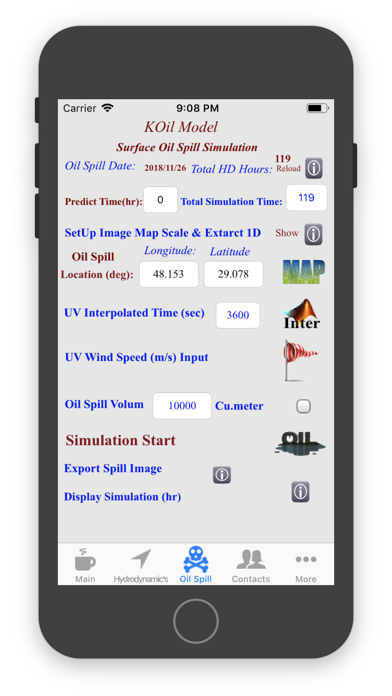
KOil App is the first Engineering applications for Oil Spill Dispersion and Trajectory in Arabian Gulf water by smart mobile device.
The use of numerical modeling in oil spill incidents is a well established technique that has proven to provide cost-effective and reasonable estimates of oil surface drift. Good predictability of such models depends highly on the quality of the input data of the incident and on the model calibration effort.
This App presents the results of simulating oil spill trajectory in the Kuwait Water and Arabian Gulf water on smart devices [IPhone/IPad]. This App employed 2-D hydrodynamic by KGulf model [Al-Salem 2009] combined with oil spill model [KOil Model (Al-Salem 2012)].
The performance of the hydrodynamic model was tested against measurements of tidal fluctuation and sea currents at selected locations for more information on validation of the KGulf Model go to http://www.hceatkuwait.net/web_pas/web-KGulf/KGulf_report.pdf.
The Oil Spill analysis (KOil App) was setup using the flow field produced from the hydrodynamic simulation and its performance was further validated against documented events like Al-Shuabaa Kuwait Aug 2, 2010 oil spill. The comparison of the actual and simulated oil spill drift was found reasonably acceptable allowing for further application in risk assessment in the entire Kuwait Water and Arabian Gulf as well. For information on KOil model concept and validation goto [https://www.researchgate.net/publication/268386738_Interactive_Oil_Spill_Model_for_Kuwaiti_Territorial_Waters_by_IPhone_Technology]
In this approach, the a Lagrrangian discrete of moving parcel algorithm is used. In this algorithm, the oil slick is viewed as a large ensemble of small parcels. The movement of each parcel is followed and recorded as functions of time relative to a reference grid system fixed in space. In the Lagrangian discrete- parcel algorithm, the oil slick is divided into a large number of equal masses. These parcels are introduced into the system in case of instantaneous spill at the spill site at the same time. Each parcel is then allowed to move with the drift velocity. The drift velocity is computed as the weighted velocity of current and wind. The component of velocity due to diffusion of oil slick is calculated by random walk analysis. The computation for oil parcels calculated numerically by integrating the drift velocity in each time interval. After the advection and diffusion calculations are completed for the current time step, oil parcels in the slick are further spread according to the spreading laws. The mass in each parcel is also reduced by an equal amount determined from evaporation rate.
KOil app can share Predicted result by Email with attachment file and images by WhatsApp.
For more Information on the KOil model go to website at http://www.hceatkuwait.net/request/KOil_report.pdf"
video presentation on the KOil app go to website at http://www.hceatkuwait.net/request/Data_iphone.htm"
The internet Version: http://www.hceatkuwait.net/web-OilSpil/KOil2/koilmain.aspx



